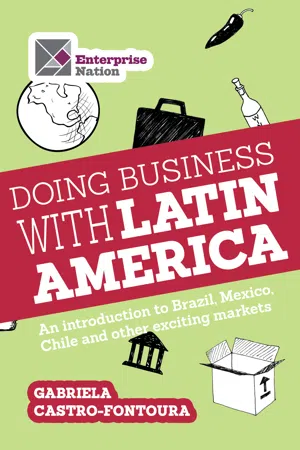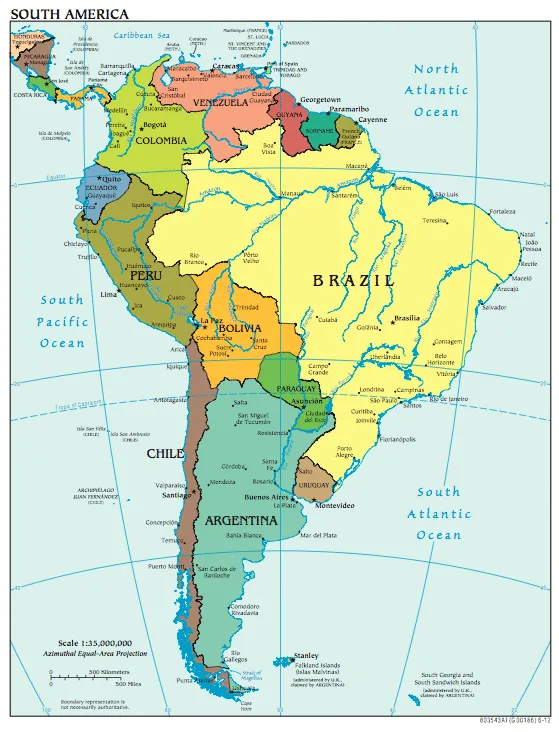1. What is Latin America?
Latin America is not just one market; there is no such a thing as the ‘Latin American market’, just as there is no ‘European market’. Would you say that selling to the Czech Republic is the same as selling to Wales or Norway? Surely not. Is it only the language that makes them different? Surely not.
My experience in the UK shows me that most business owners will struggle to define what ‘Latin America’ means or even to name more than a handful of Latin American markets. They often get confused between South America, Central America and Latin America. They ask me if Brazil is included in Latin America. And what about Mexico? Is Jamaica?
So, without further ado, let’s discuss what Latin America really is.
There is a geographical division of the Americas into North America (Canada, USA, Mexico), Central America (all the countries south of Mexico to Panama, including those in the Caribbean such as Cuba and Jamaica) and South America (all the countries south of Panama, which include French Guyana, Surinam and French Guiana). Sometimes, particularly in the UK, Central America is split into Central America and the Caribbean or Central America and the English-speaking Caribbean.
The maps below illustrate the divisions of the Americas into North, Central and South America (source: The World Factbook, www.cia.gov/library/publications/the-world-factbook).
So no mention of Latin America yet? Well, Latin America is not a geographical unity but a cultural and linguistic one. As the name hints, it encompasses all countries of Latin origin, which means all of those speaking Spanish and Portuguese.
Therefore, Latin America includes Mexico, all the Spanish-speaking Central American countries (El Salvador, Dominican Republic, Costa Rica, Nicaragua, Honduras, Guatemala, Cuba, Panama), Brazil (the only Portuguese-speaking country), all Spanish-speaking South American countries (Colombia, Venezuela, Peru, Ecuador, Chile, Bolivia, Paraguay, Argentina and Uruguay). It does not include the non-Spanish and non-Portuguese speaking countries in South America (of which there are three: Surinam, French Guiana and Guyana).
You can see that the definition of Latin America is a cultural one and it will vary from person to person. Some will include Trinidad and Tobago and Haiti as part of Latin America as well as Surinam, French Guiana and Guyana. After all, the official language of some of these countries is French, which is of Latin origin. Cultural allegiances also vary over time, are extremely subjective and not always geographically-motivated.
Using my criteria, here is a list of all the countries of Latin America, with population data.
North America
Mexico – 114,975,406
Central America
Belize – 327,719
Guatemala – 14,099,032
Cuba – 11,075,244
Dominican Republic – 10,088,598
Honduras – 8,296,693
El Salvador – 6,090,646
Nicaragua – 5,727,707
Costa Rica – 4,636,348
Panama – 3,510,045
South America
Colombia – 45,239,079
Venezuela – 28,047,938
Ecuador – 15,223,680
Peru – 29,549,517
Brazil – 199,321,413
Bolivia – 10,290,003
Paraguay – 6,541,591
Chile – 17,067,369
Argentina – 42,192,494
Uruguay – 3,316,328
Source: The World Factbook (www.cia.gov/library/publications/the-world-factbook)
Therefore, we are talking about 20 countries and a total population of nearly 576 million people.
In terms of size, the whole of Europe could fit into Brazil, which covers an area of 8,514,877 sq km (to give you a point of comparison, the UK has an area of 243,610 sq km). Uruguay, the smallest country in South America (doesn’t it look tiny on those maps?) is actually bigger than England (Uruguay, 176,215 sq km; England, 130,395 sq km), although it has a population of 3.3 million people.
Having clarified the definition of Latin America, I will give you a little flavour about this region. The intention is not to provide an academic introduction, but to make you aware of a few points that will help you understand the region better.
History
All of the countries were former colonies of either Spain or Portugal. Therefore, commercial attachment to these countries is still strong. Most countries became independent in the period 1810 to 1830.
More recently, you might remember that most Latin American countries had dictatorial governments in the 1970s and early 1980s. Without entering a political or historical discussion, this is very recent history and it is highly contentious.
Religion
Catholicism is still the dominant religion in all Latin American countries, although practice of the religion varies across the region. For example, the countries in the South of South America (such as Chile, Argentina and Uruguay) are traditionally more liberal and less focused on religion than, for example, Colombia in the north.
This is a generalisation and there will be great variations across regions within a country and huge differences between cities, towns and the countryside, plus differences between families. In Brazil, religion is far from homogeneous and African-American religions are extremely strong in some regions, for example.
Inequality
Latin America is the most unequal region in the world. While it is home to some of the world’s richest millionaires, the level of poverty in every single country can be shocking. It is important to think of what the implications are for your business. If you produce luxury goods, you will certainly find a market. But if you deliver services to tackle crime or improve water supply to poor areas, that will also be in high demand.
At the same time, the middle classes are growing due to the recent economic boom. UKTI estimates that there are now 300 million middle class consumers in Latin America (‘The Stable Consumer? The Expansion of the Middle Classes in Latin America’, UKTI, October 2011). However, the middle class will vary considerably within itself. Many retailers, for example, are targeting those new to the middle class while others are targeting the upper middle class that is trying to differentiate itself from the new middle class consumers.
How do all these groups behave? What really matters to them? What are they looking for? Some will be focused on ensuring education for their children while some will focus on real estate. Some will look for foreign brands (from coffee to handbags) that signal their socio-economic status.
Immigration
Latin America has long received immigrants from all over the world. You will notice that in the coastal areas of Colombia, for example, there are strong Arab populations (with great expertise in international trade), while in the capital cities of Uruguay and Argentina the Jewish community is very strong. Italian immigration was particularly strong in Brazil, Argentina and Uruguay (the Atlantic coast), and Chile, which has had a great influence on culture but also in consumption patterns and international trade (for example, many of the Italian immigrants brought with them their wine-making skills and hence the Italian name of many of the vineyards particularly in Chile, Argentina and Uruguay). Spanish immigration was, of course, the strongest.
What Latin American trade means to Britain
Britain has played an important role in trade with Latin America, particularly in the 1800s. British industry was key in developing utilities, transport and also education in some countries, such as Argentina and Uruguay.
Since the Second World War, Latin America has been a lot more US-facing than UK-facing. The US still dominates trade with Latin America and tends to be the first country that Latin Americans go to when they are thinking of buying abroad (whether business-to-business or business-to-consumer).
However, political disillusion with the USA is making it more interesting for non-US businesses that approach Latin American businesses. You might be the first European, and very likely the first UK busi...




